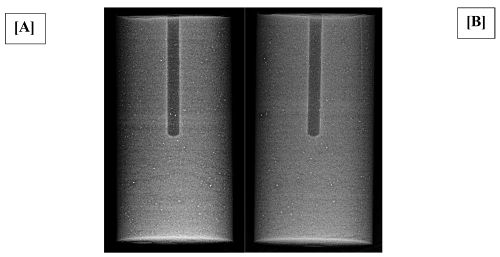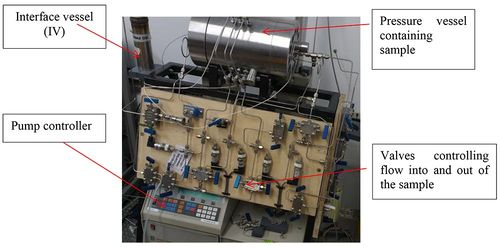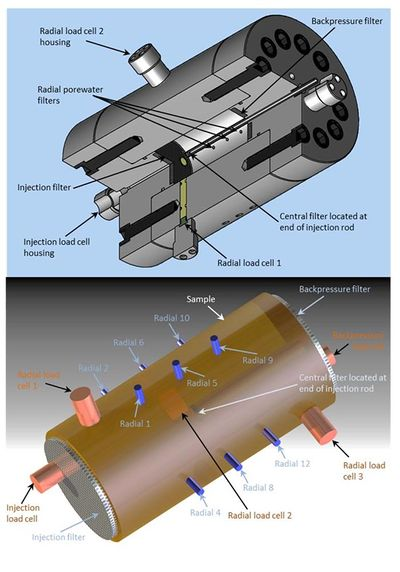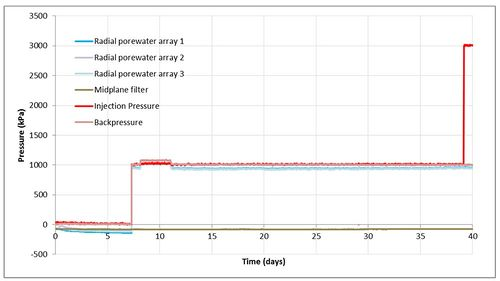OR/17/067 Experimental approach
| Daniels, K A, and Harrington, J F. 2017. The response of compact bentonite during a 1-D gas flow test. British Geological Survey. (OR/17/067). |
Sample preparation
A 1-D gas injection test has been conducted on a sample of pre-compacted Mx80 bentonite supplied by Clay Technology AB (Lund, Sweden). The bentonite had dry and bulk densities of 1.56 kg/m3 and 1.99 kg/m3 respectively (Table 1). The pre-compacted bentonite was cut into a cylinder using a machine lathe yielding an accurately dimensioned sample that formed a snug fit with the internal bore of the testing apparatus; the length of the cylindrical sample was cut parallel to the compaction direction. The sample was machine lathed without cutting lubrication and care was taken to minimise moisture loss by keeping the sample wrapped in plastic packaging wherever and whenever possible. A hole at the midplane of the sample with a diameter of 6.35 mm was drilled from the backpressure end of the sample to a depth of 64.8 mm, to allow a stainless steel tube with a filter at its tip to be inserted into the sample (providing a static measure of gas pressure during testing). The hole at the midplane was also drilled using the machine lathe at 200 rpm; the drill bit did not clog and no heat was able to build up in the clay during the drilling of the hole. The sample was stored in vacuum-sealed packaging when not in use and the sample dimensions and weight were recorded prior to testing. X-ray radiography was used to image the fabric of the bentonite before the sample was installed into the experimental apparatus and once the test had concluded and the sample had been removed from the rig (Figure 1).
| Length (mm) | Diameter (mm) | Weight (g) | Dry Density (kg/m3) | Bulk Density (kg/m3) | |
| Sample Mx80D | 119.88 | 59.59 | 671.65 | 1.56 | 1.99 |

Method
Apparatus
A constant volume pressure vessel, comprising a custom-built hollow 316 stainless steel cylinder and two detachable end-closures, was used for the testing (Figure 2). The pressure vessel was instrumented with 2 axial and 3 radial load cells, as well as 3 radial arrays of 4 porewater pressure transducers that were positioned regularly around the circumference of the vessel. The name, position and measurement type of each instrument used in this test are detailed in Table 2 and Figure 3. De-ionised water (DI) was used as the permeant to hydrate the sample prior to gas testing, and subsequently, as the backpressure fluid during the gas test. Helium was used as the permeant. The fluids were supplied to the sample through sintered stainless steel filters with a 3 mm thickness, positioned at each end of the sample and over the ports to the porewater pressure transducers.

Procedure
Before installing the sample, the radial filters (Table 2), connecting stainless steel tubing and the backpressure filter were flushed with DI to remove any air from the system. The injection filter was maintained dry to prevent water from entering the injection side of the sample ahead of the gas during the gas testing. The sample was slotted into the pressure vessel, the end-closures were fitted and the tubing was connected. The injection axial load cell housing was loosened before the injection end-closure was fitted so ensure that the pushrod between the clay and the load cell remained free-moving. The caphead screws on the backpressure end-closure were tightened first and to their maximum extent so that the end-closure was flush with the body of the vessel. The caphead screws on the injection end-closure were subsequently tightened to an approximate torque of 8 Nm, resulting in a gap of 1.89 mm between the end-closure and the vessel body and the application of an initial pre-stress on the axial faces of the sample of 3127 kPa (injection) and 5145 kPa (backpressure). These pre-stresses dropped to 2566 kPa and 3680 kPa respectively before increasing again as the clay hydrated.
| Array | Sensor name | Axial distance from backpressure face (mm) | Rotation around bore of vessel (degrees) |
| Axial stress | Injection load cell | 120 | 90 |
| Radial stress | Radial load cell 1 | 104.8 | 0 |
| Radial stress | Radial load cell 2 | 60 | 120 |
| Radial stress | Radial load cell 3 | 15.2 | 240 |
| Axial stress | Backpressure load cell | 0 | 30 |
| Radial porewater array 1 | Radial 1 | 81.4 | 330 |
| Radial 2 | 81.4 | 60 | |
| Radial 3 | 81.4 | 150 | |
| Radial 4 | 81.4 | 240 | |
| Radial porewater array 2 | Radial 5 | 60 | 330 |
| Radial 6 | 60 | 60 | |
| Radial 7 | 60 | 150 | |
| Radial 8 | 60 | 240 | |
| Radial porewater array 3 | Radial 9 | 38.6 | 330 |
| Radial 10 | 38.6 | 60 | |
| Radial 11 | 38.6 | 150 | |
| Radial 12 | 38.6 | 240 | |
| Midplane filter | Middle | 60 | 0 |
Volumetric flow rates were controlled or monitored using a pair of Teledyne ISCO-100DM, Series D, syringe pumps operated from a single digital control unit. The position of each pump piston was determined by an optically encoded disc graduated in segments equivalent to a change in volume of 4.825 nL. Movement of the pump piston was controlled by a microprocessor, which continuously monitored and adjusted the rate of rotation of the encoded disc using a DC-motor connected to the piston assembly via a geared worm drive. This allowed each pump to operate in either constant pressure or constant flow modes. A programme written in LabVIEWTM elicited data from the pump at pre-set time intervals. Testing was performed in an air-conditioned laboratory at a nominal temperature of 20°C ± 2°C.

Helium was supplied to the sample from an interface vessel (IV) located between the ISCO pump and injection face of the sample (Figure 4). To compress and displace the gas, water from the ISCO pump was injected into the base of the IV. In this way, the gas was water saturated and thus would not have a drying effect on the clay and the gas pressure could be increased or controlled depending on the needs of the test. The test comprised two stages: hydration of the sample (Stage 1) followed by gas testing (Stage 2). After gas breakthrough and a period of gas flow through the sample, the injection pump was stopped whilst the swelling pressures (stresses) and porewater pressures were continuously monitored. The test ran for a duration of 265 days.

Sample hydration
After installation, the sample was allowed to equilibrate with the water in the radial filters and backpressure end-closure filter for a period of 7.3 days. There was no air in these filters; the injection filter however was dry and no water was present in the tubes to the midplane filter. At the start of the test, the porewater pressure was at atmospheric pressure. During this hydration, the porewater pressure in each array and axial backpressure filter was monitored (Figure 5), as was the development of the swelling pressure (Figure 6).


At day 7.3 active hydration of the sample began by pressurisation of the backpressure and radial filter arrays using DI water. To this end, the backpressure pump was initially set to 500 kPa. Next, the 3 radial arrays were pressurised using the backpressure pump, while a helium gas pressure of 1 MPa was generated in the injection filter (using the injection pump). Backpressure in the axial and radial arrays was then increased over the space of 2 minutes in 100 kPa steps to 1 MPa. The sample was allowed to hydrate for the following 32 days (Figure 5 and Figure 6). The gas pressure in the injection filter was maintained constant at 1000 kPa to prevent water ingress from the hydration systems into the injection filter.
| Date | Test Day | Pump Volume Before | Pump Volume After | Comment |
| 10/03/16 | 0 | 47.97 ml | Pump A starting volume | |
| 10/03/16 | 0 | 102.99 ml | Pump B starting volume | |
| 17/03/16 | 7 | 300 ml | Starting IV volume of He at 845 kPa | |
| 17/03/16 | 7 | 102.99 ml | 49.72 ml | Pump B vol. decrease to raise IV He pressure to 1000 kPa |
| 18/04/16 | 39 | 20.45 ml | 101.42 ml | IV refilled with He at 3000 kPa |
| 03/05/16 | 54 | 6.25 ml | 102.15 ml | Pump A refilled with water |
| 10/05/16 | 61 | 40.75 ml | 100.88 ml | IV refilled with He at 8715 kPa |
| 10/05/16 | 61 | 34.8 ml | 6.58 ml | Pump B drained |
| 16/05/16 | 85 ml | 14 ml | Pump B drained | |
| 17/05/16 | 72.7 ml | 9.7 ml | Pump B drained | |
| 17/05/16 | 40 ml | 11.7 ml | Pump B drained | |
| 18/05/16 | 71 ml | 9.5 ml | Pump B drained | |
| 18/05/16 | 39 ml | 9.1 ml | Pump B drained | |
| 19/05/16 | 70.9 ml | 8.9 ml | Pump B drained | |
| 19/05/16 | 40 ml | 6.8 ml | Pump B drained | |
| 20/05/16 | 71.3 ml | 7.2 ml | Pump B drained | |
| 27/06/16 | 89.40 ml | 25.76 ml | Pump B drained |